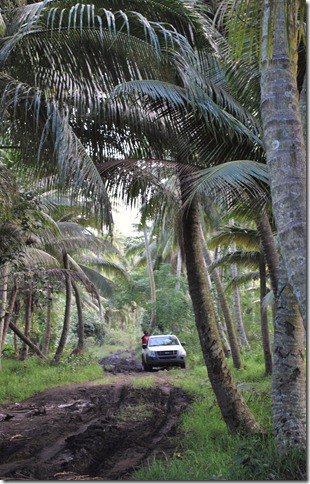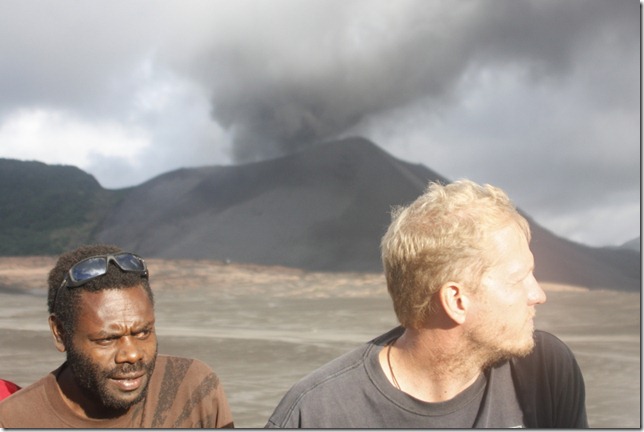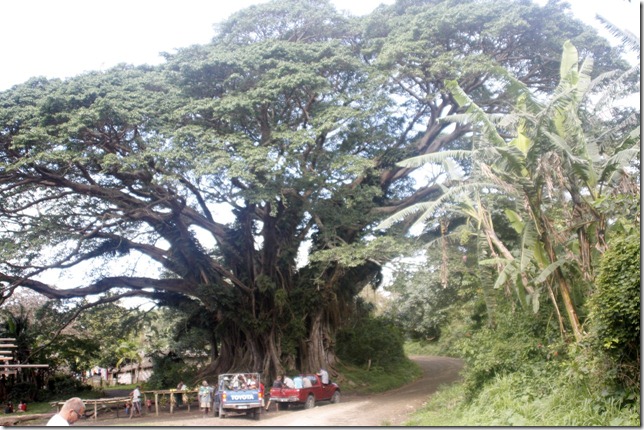Our mission in Tanna was to visit the Mt. Yasur volcano. We’d first heard about it from Ken, the Rhodesian circumnavigator we’d met before even leaving the slip in Florida and it had been on our list of destinations ever since. First, however, we had to check into Vanuatu. Anchoring near the volcano in the protected bay at Port Resolution meant we’d have to take a truck across the island to Lenekal, the official port of entry and only real town on the island. We’d made inquiries about the truck the day before and were told that there were only two in the village and one would be ready for us in the morning. After morning visits from a couple of locals in outriggers to setup fruit trades, we dinghied in to shore.
Everyone was ready and waiting for us. Dawha was our driver. He’s 18 and been driving “professionally” for 3 years. His Dad Nelson and uncle Stanley were going to accompany Ash, Colin, and me to Lenekal and back. The ride was $20 round trip per person and would take two hours each way. The truck was a small red Mitsubishi diesel 4WD with a raised suspension and large, impressive tires. There was room for one passenger in the cab and the rest rode on a narrow wooden bench that circled the small bed of the truck. Almost immediately after leaving the village we realized that the raised suspension and large tires weren’t there to impress the other villagers. They were absolutely necessary if we were even going to get a few miles away from Port Resolution. There had been heavy rains recently and the “new road” had washed out, so we were taking the old road for the first few miles. Within minutes we were stuck when one of the rear tires dropped into a large rain-washed rut that was steep sided and more than two feet deep. After a bit of yelling and getting out to check our situation, Dahwa was able to drive us out without anybody getting off and we continued down the dirt track through the jungle that was often more wash-out than road. At especially narrow and dangerous spots, the locals had placed large sticks upright in the road to mark the edge of the navigable portion. We were white knuckled not out of fear or excessive speed (it was pretty slow going at first), but simply from the effort needed to balance on the narrow board or edge of the truck bed and to stay in the truck as it bounced and lurched along. We crossed over several makeshift bridges, including one that was made from two groups of three coconut tree trunks. Each group of three relatively closely-spaced trunks made a sort of lane for one set of tires to drive down lengthwise. It was clear that in heavy rains the other side of the island would be unreachable.
 Local pickup navigating the “Tanna Highway”
Local pickup navigating the “Tanna Highway”
As we drove along, the condition of the road began to improve a little and we passed small traditional villages with thatched roof huts and people out gathering food. Much of the forest here it still untouched and it was truly amazing. Apparently the world’s 3rd largest banyan tree is here on Tanna, but the banyans we saw along the road were far larger than any we’d ever seen. Some had tree houses built in them that actually housed families, and we passed one small tourist resort that advertised banyan tree houses.
After an hour or so, we began to see the crater of the volcano above us, belching smoke, and before long we entered the volcano’s ash field. It was like a gray desert moonscape. The cleared road gave way to tracks over volcanic ash, and then the ash itself began to rain down on us like small particles of sand falling from the sky. The going was smooth now and the truck gained speed as we flowed over ash and stared up at the volcano’s crater. It was like a 1000-foot gray sand pyramid in the shape of a stingray’s back that would belch a slow mushroom of dark gray smoke every few minutes. We’d heard over the radio that Stanley was afraid of the volcano and didn’t make the best tour guide, and as soon as we entered the field area he pulled his shirt over his head to block the ash and had a rather unhappy look on his face. I asked him about the native beliefs regarding the volcano and he said that the volcano’s name, Yasur, and the name of their god were the same. They believed that the volcano’s rumblings and eruptions could be “read” for signs about the weather, harvests, etc. but that the people didn’t do anything to try to please the god/volcano. Apparently Yasur has a mind of his own. We were really awed the whole time we were in the ash field. Both there and on the way back there were a few other locals there walking around, though I’m not sure what they were doing. On the way back we noticed a soccer field setup at the edge of the ash field and locals kids busily engaged in a heated game of soccer while the volcano belched away beside them.
 Nelson and I in the back of the truck as we’re crossing the ash field. Behind us smoke is rising from Mt. Yasur. (Photograph by Colin Murphey – http://www.deadreckoningreports.com)
Nelson and I in the back of the truck as we’re crossing the ash field. Behind us smoke is rising from Mt. Yasur. (Photograph by Colin Murphey – http://www.deadreckoningreports.com)
After leaving the ash field we began to climb and after seeing some picturesque views of Tanna from atop the mountains, we descended into Lenekal. Only at the outskirts of Lenekal did the road become as good as the typical dirt road in the US.
Throughout the town, we got a better taste of the local national language – Bislama. It is like a creole or pigeon English. If you read it aloud to yourself you can typically make it out, but the spelling is pretty comical if, like most people, you’re used to proper English where for whatever reason it’s not important to consistently spell words the way they sound. In the IsiBank (Easy Bank, the national bank), we read signs about what to do if you “wantem mane” to start a “smol bisnis”. Across the street from the bank was the Nambawan (sound it out) Coffee Cafe. We have a few photos, but it’s probably worth Googling Bislama signs or phrases or something like that to have a laugh.
After taking care of formalities (including having to chase down the quarantine officer), changing money (no way to get money from a card in Tanna), and eating lunch ($3 at a local restaurant) we were ready for the afternoon drive back. The drive back was much the same, except that when I sat back down on the hard, narrow wooden bench I realized that being woefully short of natural cushioning, I was already feeling a little bruised and the ride back would be a long one. We were joined by some more locals in the back of the truck, 8 or 9 of us all together. Young kids were out from school, but instead of sitting at home watching TV like in the US, they were generally out playing soccer barefoot or, machete in hand, walking out to gather fruit or vegetables for the evening meal. I couldn’t help but imagine what a US mother would think if her child showed up at home at 4pm barefoot, with a 2-foot machete, a big smile, a hand full of tropical fruit.
While passing one village, we drove through a festive procession of young children and adults where the young girls were dressed up in a native dress. They all yelled as we passed by and were clearly happy about something. Nelson told us that it was a coming of age procession and ceremony for the girls of the village. We stopped at a roadside veggie stand beside a giant banyan tree (at least 20 feet across) and the locals bought bundles of fresh peanuts and kava roots. I picked up some large pamplemousse. We haven’t seen them since French Polynesia and are enjoying them here. The fresh peanuts were pretty tasty; they’re totally different than the roasted ones we usually eat and taste a lot more like firm, fresh peas from the garden. At the veggie stand, Dawha and Nelson worked to re-attach the Argentina flag on the truck’s antenna. Soccer and the World Cup are all the rage here and many people have the flag of their favorite team flying somewhere. The games are during the middle of the night, so lots of the cruisers and villagers have been missing sleep to see them. There’s one TV with a satellite connection in the Port Resolution village that airs the games live for people to watch.
 Roadside fruit & veggie stand under a wee banyan tree (Photograph by Colin Murphey – http://www.deadreckoningreports.com)
Roadside fruit & veggie stand under a wee banyan tree (Photograph by Colin Murphey – http://www.deadreckoningreports.com)
During our second trip through the ash field we raced another truck to the other side. Aside from a fixed spot to drive through the river that crosses the ash field, there isn’t any road per se, so Dahwa took a longer route at a higher speed to head off the other truck. In the back of the other truck was a white-haired grandmother who was sitting on a box chewing on a piece of fruit. She laughed and waved as we sped by and we had to laugh as well. Not too far past the ash field we passed Lauren, Shiroma, and a groups of other cruisers making the 3 hour walk up to the crater’s edge. We said hello, dropped off a couple of pamplemousse, answered the repeated questions about which one was my wife, then headed back to the boat to get ready for the ride up to the volcano to meet them.

